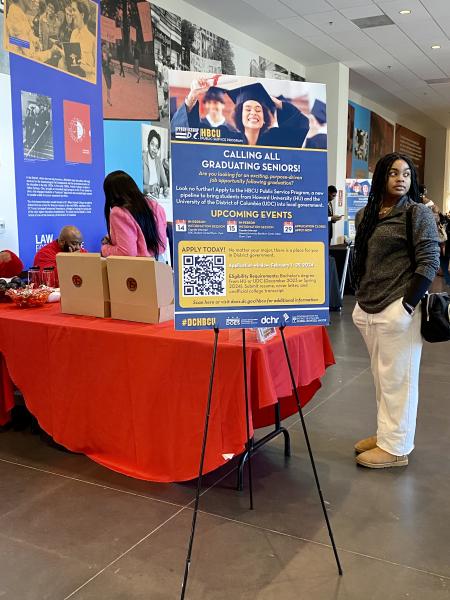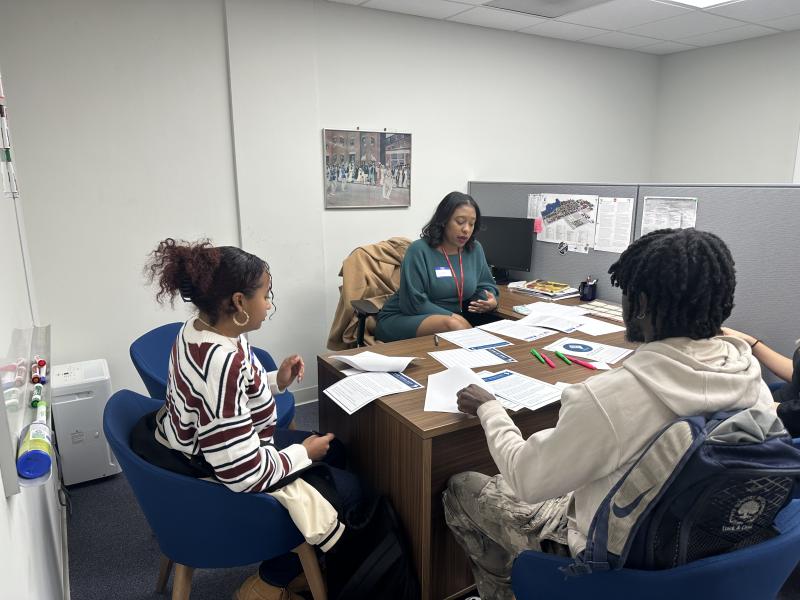Year 2: Transforming the District’s Hiring Practices
Our second year of work centered on modernizing and streamlining the District’s hiring process. By partnering with key agencies, external stakeholders, and community organizations, we set out to understand existing hiring challenges, generate new ideas, and deliver solutions that attract and retain top talent in the District.
Understanding the Problem Phase (March–May 2024)
Data, Research, and Listening

- Listening to Agencies and Job Seekers
We engaged with the Department of Human Resources (DCHR), Fire and Emergency Medical Services (FEMS), the Department of Employment Services (DOES), and other agencies to map out each step of the hiring process. Interviews with job seekers—including students—helped us learn why certain roles (like EMS and specialized positions) remained “hard-to-fill.” - Vacancy Announcement Analysis
Confusing or out-of-date job postings were a recurring pain point. We collected job postings from multiple agencies and discovered mismatched language and lengthy, unclear descriptions driving away qualified applicants. - PeopleSoft (Applicant Tracking System) Feedback
Through surveys and user testing, we uncovered how PeopleSoft’s cumbersome interface increased the time-to-hire and discouraged applicants. Hiring managers noted complicated internal workflows, while job seekers encountered mobile inaccessibility and confusing forms. - Spotlight on Diversity and Inclusion
Our early research recognized that many roles lacked diverse candidate pools. We set our sights on pathways to spark interest in government careers, especially in areas like FEMS paramedic training, nursing, and social work. - Community Engagement: Gratitude Powers DC Crossovers
While mostly designed to celebrate community heroes, our Gratitude Powers DC events also uncovered residents’ eager to tap into the District’s online employment resources.
Key Takeaways
- High Administrative Hurdles: Long forms, unclear announcements, and redundant PeopleSoft questions.
- Uneven Recruitment Efforts: Need for proactive outreach, including to local students and underrepresented communities.
- Staff Frustrations: Manual tasks slow down everything from candidate screening to final offers.
Generate Ideas Phase (June–July 2024)
Prototyping and Co-Creation

- Vacancy Announcement Pilot Project
Building on research, we drafted “Guidelines for Writing Vacancy Announcements” to ensure clarity, concise descriptions, and user-friendly postings. The pilot with three agencies (OCTO, OCP, DPR) let us test new formats and gather data on applicant volume and quality. - PeopleSoft Enhancements
We mapped quick-win improvements—like eliminating redundant fields, creating a more intuitive mobile view, and building better notifications for both applicants and staff. - Pathway to Public Service Program
To inspire more diverse applicants, we engaged Howard University and the University of the District of Columbia (UDC) students in focus groups, shaping a first-year apprentice program with 25 students in 11 agencies. We also planned an Implementation Study to evaluate how well each agency supports their apprentice. - FEMS Recruitment Partnership
In partnership with Fire and EMS, we tested new approaches to attract more women and people of color into paramedic and firefighter roles. Proposed solutions included social media campaigns, “Camp Spark” expansions, and real-time paramedic class visits to highlight career pathways. - Gratitude Powers DC
Our successful community events celebrating agencies like DPR and MPD also became mini recruitment opportunities. We tested “pop-up job info tables” that gave job seekers quick Q&A with representatives of District government agencies.
Decision Points
- Vacancy Announcement Revisions: Agency buy-in was strong, so we greenlighted a larger pilot.
- PeopleSoft Upgrades: The i-team identified technical fixes for immediate rollout, plus a roadmap for bigger overhauls.
- Pathway to Public Service Apprentice Program: Early evaluations justified continuing the program with improved training, surveys, and dedicated mentors.
- FEMS: We decided to co-fund marketing materials and new “Camp Spark” sessions to reach high school girls.
Deliver Solutions Phase (October 2024–December 2025)
- One Hiring Front Door: Aggregate Jobs Page (Phase 1 launch May 2025 → full feed July 2025)
- What’s coming – A single, searchable landing page that pulls vacancies from all District agencies—ending the “hunt-and-peck” experience created by 26 independent hiring authorities. Jobs will be grouped by occupation family (IT, public safety, policy, trades, etc.), with smart filters and plain-language job previews.
- Early wins – User-testing prototypes cut “time-to-find” a relevant posting by 60 percent.
- Next milestones –
- May 23, 2025: Phase 1 live (eRecruit + two partner agencies).
- July 25, 2025: All executive-branch agencies onboard; API spec opened to OCFO, DCPL, UDC.
- eRecruit Modernization & AI-Assisted Screening (June – November 2025)
- Quick-fix bundle rolling out June removes 20+ redundant fields, adds an autosave draft, and displays application status in a new “Pizza Tracker.”
- Resume Parser pilot (July) will pre-populate work-history fields and is projected to trim application time from 55 → 35 minutes.
- AI Hiring-Manager Tool pilot (June) surfaces the top 20 percent matches for hard-to-fill roles, freeing HR staff for relationship building.
- Service-level agreements and an eRecruit Insights Dashboard go live by December, sending automatic alerts when cases stall.
- Pathway to Public Service Program — Cohort 2 (Recruitment April – June 2025; onboarding July)
- Bigger, broader pool – Eligibility expanded to graduates of other universities and DC residents who studied outside the region. Target: 180 pre-screened applicants for 25–30 slots.
- Support upgrades – Early-career mentorship board, tailored training tracks (IT, paramedicine, policy analysis) and a mid-year retreat.
- Evaluation loop – End-line study (Aug 2025) will measure skill gain, retention, and agency readiness—informing a replicable model for other cities.
- FEMS Talent Pipeline (Spring 2025 → launch of new Paramedic School Jan 2026)
- “Camp Spark 2.0” and Girls-in-EMS roadshows expand to 150+ participants, backed by a social-media micro-campaign co-designed with alumnae firefighters.
- Curriculum co-creation sessions (Mar–Aug 2025) align the new UDC-FEMS Paramedic School with licensure requirements and learner feedback.
- Vacancy-Announcement Makeover (Beta April → Citywide August 2025)
- Three-agency pilot showed a 30 percent rise in completed applications and crisper candidate pools. Final templates, inclusive language library, and a style-checker plug-in ship in August alongside the jobs page.
What Success Looks Like by December 2025
| Metric | Oct 2024 Baseline | Target Dec 2025 |
|---|---|---|
| Avg. time it takes for applicants to submit an application on eRecruit | 55 min | ≤ 35 min |
| Percentage of abandoned applications after initiated | 41% | ≤ 20% |
| Number of days to fill a critical vacancy | 134 days | ≤ 85 days |
| Percentage of apprentices retained following 1-month of program completion | New program | ≥ 85% |
| Number of unique visitors to the Aggregate Jobs page in a month | n/a | 75,000 |
Over the next nine months the i-Team will move from isolated pilots to integrated, resident-facing tools—linking clearer job ads, faster applications, and a bigger talent pipeline. By December 2025, District hiring will be simpler, fairer, and measurably faster—setting the stage for a truly resident-centered digital government.

